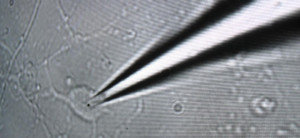Electrophysiology and Patch-Clamp: technique to measure electrical activity of isolated ion channels
Project Coordinator: Célia Carlini, PhD
Invited Researcher: Vitya Vardanyan, PhD , from the Institute of Molecular Biophysics of the Academy of Sciences of the Republic of Armenia
The Patch-Clamp is a powerful technique for studying the electrical activity of cells, in particular neurons, the main cells of the nervous system. Bioelectrogenesis, the property of cells to generate electrical currents and thus communicate with each other, involves several types of molecules and inorganic ions. Proteins called receptors, present in the outer membranes of cells, perceive and interact with chemical signals - the neurotransmitters - that a nerve cell produces to communicate with another cell, which may be another neuron or a muscle cell.
Other proteins in the cell membrane serve as channels, through which ions such as sodium (Na +), potassium (K +), calcium (Ca2 +) or chloride (CL-) pass through and leave the cell. during the cellular communication process. The recording of the electrical activity of an entire cell or a network of cells detects many channels and receivers functioning simultaneously, which makes it difficult to understand the importance of each of these events. The Patch-Clamp uses a glass micropipette, 100 times thinner than a hair, which just touches the surface of the membrane or “sucks” a small piece of a cell's membrane. This micropipette is an electrode capable of detecting electrical currents and ion exchange that occur in the small area of the analyzed membrane. In this way, it is possible to study the electrical activity related to a single type of ion channel or neurotransmitter receptor, separate from the many others present in the same cell. This type of study is important to understand what happens in many pathologies of the brain, in which a certain type of neurotransmitter channel or receptor protein is altered. The photo on the page shows a microelectrode touching a neuron.
In this context, InsCer develops research with PhD Vitya Vardanyan, from the Institute of Molecular Biophysics of the Academy of Sciences of the Republic of Armenia, in Yerevan. Specialist in electrophysiology and in the study of potassium channels, Dr. Vardanyan spent four months at InsCer, as a visiting researcher at CNPq at the invitation of PhD Célia Carlini. In addition to helping implement the patch-clamp technique within the scope of InsCer, Vardanyan participated in research projects with the researcher, who investigates the neurotoxicity of ureases.



